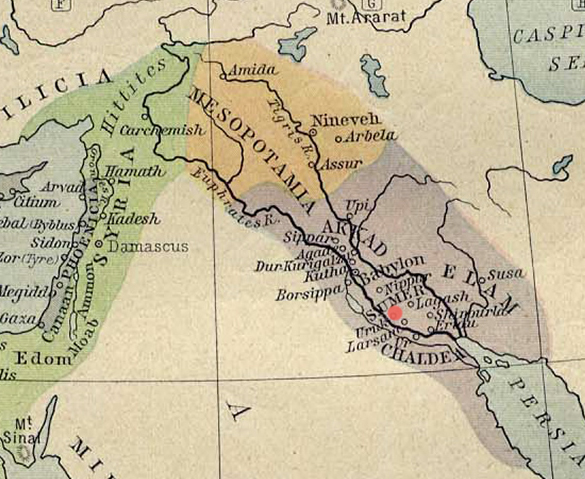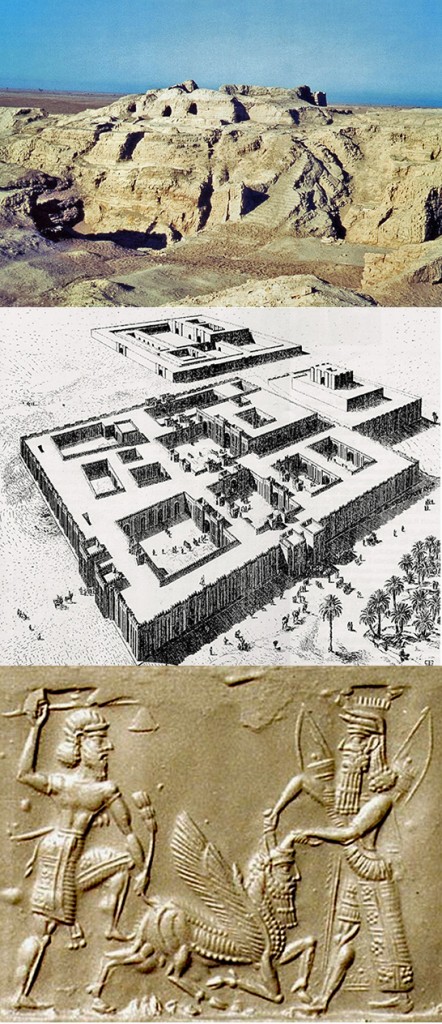Page 11 of The Mythic Roots of Western Culture’s Alienation from Nature. Adams and Belasco. Tapestry Institute Occasional Papers, Volume 1, Number 3. July, 2015. Outline / List of Headings available here.
The Oldest Dark Forest, Fiery Desert Myth on Record

The woodcutter who rescued Little Red Riding Hood with his ax has much older roots than might be guessed. Jakob and Wilhelm Grimm published collections of German folk tales between 1812 and 1818 (46), though of course those stories had been passed down orally for generations before. But the first written record of a Hero with an ax — who uses it to slay a monster and then cut down a monumentally large tree — is literally the oldest written story in Western culture: The Epic of Gilgamesh. This popular story has been found on numerous clay tablets from different time periods, the oldest of which date to about 2100 BCE, more than 4,000 years ago. That makes the written version of this story a full thousand years older than estimates for written texts of either the Iliad or the Bible. The epic tells of the super-human exploits of the Sumerian king Gilgamesh, who actually ruled the historical Mesopotamian city of Uruk around 2750 BCE (47).

Uruk was one of the earliest great cities of the fertile land between the Tigris and Euphrates Rivers where historians and archeologists believe Western civilization began. Its name is a word meaning “sheepfold” or “haven.” The ruins of Uruk still exist, about 190 miles south of Baghdad, Iraq, and archeological reconstructions show it to be very much as it’s described with wonder and pride in The Epic of Gilgamesh (49):
“[Gilgamesh] built the wall of Uruk-Haven, . . .
Go up on the wall of Uruk and walk around,
examine its foundation, inspect its brickwork thoroughly.
Is not even the core of the brick structure made of kiln-fired brick,
and did not the Seven Sages themselves lay out its plans?
One league city, one league palm gardens, one league lowlands, the open area of the
Ishtar Temple,
three leagues and the open area of Uruk the wall encloses.”
The most commonly translated version of The Epic of Gilgamesh occupies 11 separate clay tablets and the description of Uruk occurs at the very beginning of the first one. So from the outset, this oldest written story — told and recorded in the very culture, time, and place that gave birth to Western culture (50) — exhibits one of the main elements of the Fiery Desert, Dark Forest Myth: a walled fortress city. But of course it isn’t long before Gilgamesh leaves the safety of Uruk’s walls and heads out into the wilderness on a series of Heroic adventures. On the first of these, he makes a special ax, goes into a sacred Dark Forest, and cuts down the biggest tree there.
The oldest written expression of the Dark Forest, Fiery Desert Myth in existence, The Epic of Gilgamesh reveals people’s mythic view of nature in the time, place, and culture that are the root source of Western culture itself. It is therefore a Rosetta stone that unlocks the mystery of how and why people of Western culture think about nature the way they do. Because it’s so important but few people are familiar with it, we will summarize the story first by focusing on its two main characters Gilgamesh and Enkidu, and then analyze the story’s rich layers of structural elements.
Continue to Next Section: Gilgamesh and Enkidu
— or —
Return to: Introduction and Outline / List of Headings
References, Notes, and Credits
for
The Oldest Dark Forest, Fiery Desert Myth on Record
46. Ashliman, D. L. 2013. “Grimm Brothers’ Homepage” at the University of Pittsburg website. Available online at http://www.pitt.edu/~dash/grimm.html.
47. Stephen Mitchell. 2004. Gilgamesh: A New English Version. Free Press, A Division of Simon & Schuster, Inc. New York, NY., pages 1-3. Most scholarly attention on The Epic of Gilgamesh has focused on this story’s early expression of the Hero’s Journey Myth, the role of women in the story, and the intimate view of Sumerian culture the story reveals. However, a lengthy flood story in the last few tablets so closely parallels the Genesis story of “Noah and the Ark” that it drew great attention when the epic was first translated (Mitchell, Op. cit., pp. 1-6).
48. “Mycenian Greece and the Orient about 1450 B.C.” Historical Atlas by William Shepherd, 1926 ed., p.4. University of Texas Map Library. Available at http://www.lib.utexas.edu/maps/historical/shepherd/mycenean_greece_orient.jpg. Accessed July 2, 2015.
49. The Epic of Gilgamesh, Tablet I. Translated by Maureen Gallery Kovacs, Electronic Edition by Wolf Carnahan, 1998. Available online at http://www.ancienttexts.org/library/mesopotamian/gilgamesh/tab1.htm.
50. The primary features of Sumerian and Babylonian cultures in the Tigris and Euphrates River valleys that make modern scholars regard them as foundational for Western culture include first development of writing, first cities, and first formal code of laws. (Written versions of the Code of Hammurabi, regarded as the foundation of Western law, date from 1795-1750 BCE but refer to earlier and much older forms of the canon; see documentation at the Lillian Goldman Law Library, Yale University, online at http://avalon.law.yale.edu/ancient/hamframe.asp and http://avalon.law.yale.edu/ancient/hamframe.asp.) Images of Uruk and its reconstruction, a Gilgamesh cylinder seal impression, and a map showing the location of the historical city of Uruk are from the history website EmersonKent.com, at http://www.emersonkent.com/history_notes/gilgamesh.htm
